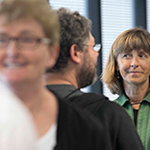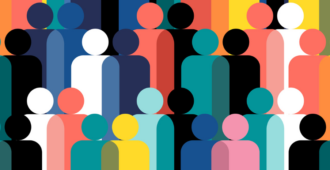
By Marge Overs, Communications Manager, The Australian Prevention Partnership Centre

It is an unlikely scene. Thirty scientists – and me – gathered in a circle, tossing around an imaginary ball, responding with an adamant ‘yes’ each time the ball heads our way.
All of the scientists, many of them senior academics from US universities, are enthusiastic about the exercise, intent on playing their part in the virtual ball game.
This is science communications training with a difference at the Alan Alda Center for Communicating Science.
The Center, at Stony Brook University in Long Island, New York, uses acting and improvisation exercises, as well as journalism tools, to help scientists communicate their science in rich and engaging ways.
I am here with scientists and academics from across the US. There are professors of psychology, chemistry and anthropology; there are astronomers, particle physicists and hydrologists. All are determined to improve how they talk about their work at a time when mistrust of science and evidence makes communication more important than ever.
The Alda method is not about turning scientists into comedians or actors, but helping them connect more vividly with their audience and become more spontaneous and flexible when they present.
As Alan Alda says: “The kind of improvising I value is not designed to entertain people. In its purest form, improv puts you in touch with other people in a way that is intimate, informal and fully engaged, so you can be aware of what they’re feeling and thinking.”
The actor and science advocate has taken his method for engaging science communications across the US and now to Australia. The Center, which has trained more than 8000 scientists, is affiliated with 17 universities and medical schools in the United States and, as of March 2016, also with the Australian National Centre for the Public Awareness of Science based at ANU.

I learnt of the boot camp when I heard Alan Alda speak last year at the National Press Club in Canberra. Alda told the packed Press Club that good communication is not about dumbing down the science – it’s about giving science clarity and showing how it affects our daily lives.
He said researchers who did the training at the Center found they were doing better science because, once they had learnt to distill the messages about their work, they looked at their work in a more focused way.
For me, it was one of those rare ‘ah, ha’ moments – Alda was talking about exactly what I had been trying to do in my role, to help researchers tell the story of their research in clear and engaging ways.
As a journalist and health communicator, story-telling and distilling messages is my bread and butter, but I’m a writer – not a presenter. Usually I’m behind the scenes, helping researchers prepare for a media interview or a presentation, telling other people’s stories. And that suits me just fine.
So I approached the boot camp with some trepidation, especially because I knew we all had to give a three-minute presentation on the final day.
I needn’t have worried. The week was designed to prepare us for that final presentation. For five days, we stepped away from our comfort zones, with every day packed with improv exercises designed to help us develop empathy with our audience. There was also a focus on activities to hone the key messages of our research, and ways to find how our research intersected with our audiences’ lives.
We became story-tellers and our research became a story worth telling.
We presented our way through the week – constantly telling and refining our stories, critiquing each other’s work and learning more about our own in the process. Many of the exercises were aimed at helping us to move beyond the standard rote research PowerPoint presentation. You all know it – the introduction, method, findings and conclusions, with a few dense graphs, tables and ‘busy slides’ thrown in for good measure.
Instead, we simply stood up and spoke – so many times throughout the week that any initial nerves soon disappeared.
Many activities resonated, but this one in particular worked for me. You could try it yourself: with a partner, take turns to talk about your research project in one minute, then reduce the time limit to 30 seconds, and then just 15 seconds. The exercise taught me how to think on my feet, refining my story to its very essence. And this was all done with very little preparation. No slides – no safety net. The result was far more engaging and effective than I have ever achieved with a scripted presentation.
For eight hours a day, we worked like this to build skills in story-telling and presentation. We learnt media skills and put those skills to the test in a videoed media interview; we learnt how to talk to difficult audiences; and we practised describing our research to policy makers and politicians (played by actors).

What did we learn? Two key lessons resonated through week: know your audience and have a goal – what do you want your audience to think, feel or do? (This was reassuring to me because I bang on about audience and purpose every time a colleague asks for a communications product.)
We learnt the importance of knowing your key messages, ditching the jargon, telling a story and revealing the person behind the science. We learnt almost as much from each other as we did from the lecturers. And it worked.
Most of us began the week with presentations burdened technical details – and by week’s end the jargon gave way to vibrant and personal stories. Each of us had to film a one-minute presentation before attending the boot camp and deliver a final presentation at the end, which was also filmed. We had three minutes and just one slide to show what we had learnt over the week.
One boot camp participant was Jason Organ, an assistant professor in anatomy and cell biology at Indiana University. Jason, who studies brittle bone disease, began his ‘before’ talk with: “My research is in bone and muscle biomechanics, which means I take an engineering approach to understanding how the biology of bone and muscles influences their function”.
His final talk began with: “I want to tell you a story about how mice on high wires are related to children with brittle bones.”
If you want to know more (and how could you resist after that opening line), Jason agreed to sharing the videos of his before and after presentations. I urge you to check them out because Jason perfectly illustrates the ‘Alda’ effect.
But Jason wasn’t the only success story. The final presentation of every boot camp participant was very different to the one that started the week. They shared insights into their lives and their passion for their research, connecting the personal with the factual.
It made me wonder whether a focus on stories and connection is the answer to communicating science in a world where emotion trumps facts and evidence. And it made me think about what happened in April, when one million people in 600 cities around the world stepped out from their labs and universities and marched for science – collectively claiming the space for evidence in policy and society.
On the final day of the boot camp, as each of us stood up to give our final presentations, we all tried to ‘claim the space’, as our improv instructor Valeri Lantz-Gefroh had urged us. Valeri said actors use this technique to prepare for performance. Whether back stage, or on stage just before the show begins, the performer stands big and tall, arms extended – literally claiming the space as their own.
Looking back at that wonderful week at Stony Brook, it seemed a fitting metaphor for what scientists need to do in this post-truth world. If we don’t claim the space of our research, others who have opposing agendas will do it for us.
And in telling the story of our science in a way that everyone can understand – and revealing the person and passion behind it – we become better scientists.
Find out more
- Read the original blog post on The Australian Prevention Partnership Centre’s website




